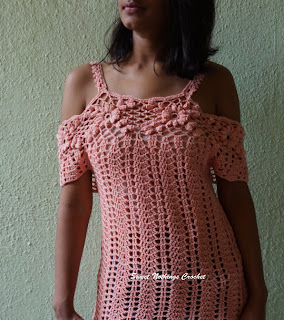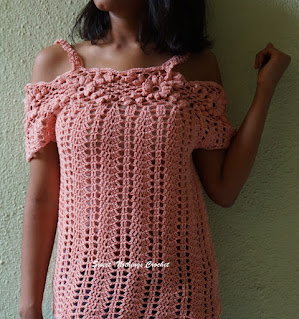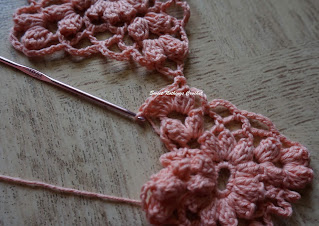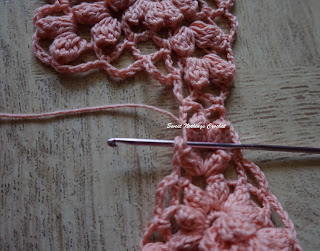OFF
THE SHOULDER TOP (5)
This
is yet another off the shoulder top in a long line of tops I’ve made in the
recent past. Not only is this the “in”
pattern presently, but it’s also a lovely one.
Thank you for joining me.
In case you have just joined me, know that you can access all of my earlier creations by checking under ‘categories’ on the right hand side of this blog under “Labels”. Then, for your convenience, follow me here or on Facebook, You Tube, Pinterest, Twitter or Instagram.
Check out all my social media handles at the bottom of this blog
Oh, and may I add that the fastest way to find any of my blogs is via Pinterest.
All my blogs can be printed. Find the printer friendly (green) link at the bottom of this blog. You can also hit Control P (or Command P for Mac) on your keyboard, and the blog will go directly to the connected printer.
Remember that you only print if absolutely essential. Save paper – Save Our Earth.
Do remember to add my blog URL when you make and show off your creation.
Just copy the link on the search bar above - that's the blog URL.
To purchase this or similar yarn online, click here to buy your yarns online via Amazon. While you will still pay the same, I may get paid by Amazon as well.
This is a free blog - so do pay it forward for me. Cheers.
International yarns : Among the international yarns I have used in this thickness, I’d suggest Aunt Lydia Cotton 10, Aunt Lydia Bamboo-Viscose 10, DMC Petra, Sullivans knitting cotton (Australia), Milford Soft, Hilaza Rustica Eclat , Alize cotton yarn and Alize bamboo yarn.
That
said, you can use any yarn with a suitable hook to work this project.
Size made : 34" (M)
You can make this to any size. This is given only for a rough estimation of yarn requirement.
Difficulty level : Advanced Skill level.
The
pattern is a pretty easy one line repeat.
There are, however, calculations that need an advanced level of
expertise.
Stitches used : Using U.S. terminology
Single Crochet : Sc : yo, insert hk into st ; yo (2 lps on hk); yo, draw through both lps. One sc made. Check out the video at
https://youtu.be/ghACqBpA-3k Double Crochet : dc : yo, insert hk into st ; yo (3 lps on hk);
[yo, draw through 2 lps] twice. One dc made.
Chainless start for Double Crochet : I dislike the ch-2 / ch – 3 start, and this is what I do to start my row of dc.
dc 3-tog : Double crochet 3-tog : [yo, insert hk in st or ch-sp, yo and pull up a lp ; yo and draw
through 2 lps] 3 times (4 lps on hk) ; yo, draw through all lps on hk. One dc 3-tog made. Here is an easy video tutorial at https://youtu.be/qlnqXDB3OUM
Popcorn stitch : First work 3 dc, then carefully take
the loops off the hook and pull the last loop out a bit ;
slip your hook into the 1st dc, pull the last loop (that you just
dropped) through ; yo and draw through both loops. One popcorn stitch made. So in effect you are 'tying' all your sts together via the last loop
How to work a picot stitch : Traditionally for a ch-3 picot, you work (ch 3, sl-st in 3rd ch from hook). For a ch-5 picot, you will do (ch 5, sl-st in 5th ch from hook).
Abbreviations used : (Using U.S terminology
lp(s) : Loop(s) sc : Single crochet
dc : Double crochet sp : Space
sl-st : Slip stitch ch : Chain
st(s) : Stitch(es) hk : Hook
yo : Yarn Over rep : repeat
fsc : Foundation Single Crochet
trc : Triple / Treble crochet
Instructions : (Using U.S Terminology)
Please note that I start all my rows with a ch 1, turning chain for ease.
Please check the top of this blog for easy video tutorials on all stitches used in today's pattern.
Please read through all my notes before you pick up your hook, so you know just where we're heading in our pattern. This is a slightly complicated pattern and I’ve got loads of notes – bear with me.. they’re all useful!
In my patterns I work with the principle of stitch count and body measurement. This means that you need to work the stitch count in pattern, till you get the measurement (length and/or width) that you need for your project.
Let
us take a quick look at what we’re working on here. I started working on the granny squares for
this top and as I ‘figured’ it out, shared the photo(s) with my friend and
Google/Pinterest Queen Rajeshwari – and she immediately shared this chart with
me. So you have two ideas on how to make
these squares.
Choices….
Decisions.. as always
We
will start with a set of granny squares which will go around the
shoulders.
This is the “Off the
shoulders” bit. So first you make one
square, measure it and decide how many you’ll need to go neatly around the shoulders.
Once
we have completed that round of granny squares for around the shoulders, the
body of the top is worked off this.
The
pattern for the body seems to be worked in trc or treble / triple crochet
stitches. You can work this in dc or
trc.
Decide
how long you want the top and work this shelled pattern all the way to the end. Keep it shorter and you have a wonderful of f the shoulder crop top all done! Continue it all the way down and you get a beautiful dress - one pattern and so many choices !
As
always, I request that you read through all the instructions before you pick
up your hook.
I stress this
particularly for this pattern as there are armhole instructions that need to be
read through once so you can visualize what you are going to do.
Please
note that I take a lot of trouble in explanations so that it can be as
clear as I can make it. Once again, I'd appreciate you share my blog post.
Part
1 : Granny squares
This is a top down construction. We start with the top
around the chest / bust and work our way to the bottom.
The off-the-shoulder portion is, as mentioned earlier,
is made up of granny squares. I also
told you there are two ways to work this.
So the one method is working Popcorn stitches all
around, and the other one (per chart) is working a dc 3-tog instead.
For a 'how to' for popcorn st as well as dc 3-tog please check the top of this blog.
So decide on what stitch you want to use, and use that
stitch.
I am writing this pattern with
the simpler dc 3-tog.
Start with a magic circle and 12 sc in that circle.
Join with a sl-st to the 1st sc. Pull lightly to close.
In the very next round, we will use a dc 3-tog.
Please check the top of this blog for a “how to” if
needed.
Round 1 : dc 3-tog in the 1st
sc ;
*ch 5, dc 3-tog in the next sc* ;
rep *to* all around ;
ch 5, and join with a sl-st to
the 1st sc
Round 2 : sl-st into the 1st
ch-5 sp ;
[dc 3-tog in the ch-5 sp ; ch 5, dc 3-tog in the same
ch-5 sp] ;
*(ch 5, sc in the next ch-5 sp) ;
rep (to) once ;
rep
[to] once in the next ch-5 sp* ;
rep *to* all around ;
ch 5 and join with a
sl-st to the 1st st.
You will now have four corners that are defined by the
[to] pattern.
As you may have guessed, we will repeat the [to] dc
3-tog in each corner all around.
Round 3 : sl-st into the 1st
ch-5 sp ;
[dc 3-tog in the ch-5 sp ; ch 5, dc 3-tog in the same
ch-5 sp] ;
*(ch 5, sc in the next ch-5 sp) ;
rep (to) 2 times ;
ch 5, rep [to] once in the next ch-5 sp* ;
rep *to* all around ;
ch 5 and join with a sl-st to the
1st st.
We have completed one granny square.
Now you will make as many granny squares as needed to
go neatly around your shoulders.
For each succeeding granny square, may I suggest that
you join as you go along one side.
To join the granny square on one side : Join it
as you regularly would, in the ch-5 sps.
So when working Granny Square 2, join one side of Granny Square 1 via
the ch-5 sps working (ch 2, join to ch-5 sp of Square 1 ; ch 2, sc in the ch-5
sp of Square 2).
You will work this from
one corner to the next along one side of the 2nd granny square
only. You will then finish the square
and move onto the next.
Each square is
joined only on one side to the earlier square – so this is pretty easy and
straight forward.
Once you have completed the full set of squares, you
will have a long length of squares. You
will finally join the last square to the other (free) side of the 1st
square you started with – thus making this a round of granny squares. So for that last square, you will join two
sides to get this round. Got it?
I hope my rough sketches / chart help.
We will work the body of our top off this row of granny squares
Part
2 : Sleeves & body of top
We will now work in rounds for the body and sleeves of
the top.
Another decision before we start off. I was thinking of working in dc here, and
find that this chart also reads dc, but the top looks like it has been
made using trc / triple/treble crochet.
I am going to write the pattern in dc. You choose your stitch and work accordingly.
For the purpose of our pattern, we will be working
stitch count in a slightly different way.
We will only be using the ch-5 sps all around, so check and see if you
have an even number of ch-5 sps.
Count even the corner points (that join 2 squares) as a ch-5, as we will
be working in that joint / corner point as well.
Depending on where you are, sl-st to the joint/corner
point or the 1st ch-5 sp. For
the sake of uniformity, I am going to say sl-st into the 1st ch-5
sp, and each sp will be a ch-5 sp (even the joint/corner points). OK?
Round 1 : 3 dc in the 1st
ch 5 sp ;
*ch 2, (dc ; ch 1, dc) in the next ch-5 sp ;
ch 2, 3 dc
in the next ch-5 sp* ;
rep *to* all around ;
ch 2, and join with a sl-st to the 1st
dc.
Stop and check that you have alternating 3 dc and (to)
patterns.
Round 2 : dc in the 1st 3
dc ;
*ch 2, 2 dc in the next dc ;
ch 1, 2 dc in the next dc
; ch 2, dc in the next 3 dc* ;
rep *to* all around ;
ch 2, and join with a sl-st to
the 1st dc.
Round 3 : sk the 1st dc ; 2
dc in the next dc ;
*ch 1, sk next dc ; dc in the next 2 dc ;
(dc ; ch 1,
dc) all in the next ch-1 sp ;
dc in the next 2 dc ;
ch 1, sk next dc, 2 dc in
the next dc* ;
rep *to* all around ;
ch 1, and join with a sl-st to
the 1st dc.
Now in case you wish to have a slightly looser / larger
top, add a dc in the centre pattern bit (i.e do not skip the dc, so you will
get dc in the 3 dc ; then (to) and 3 dc again.. so you will have 8 sts for this
set, as against 6. Got it?
Rounds 4 & 5 : dc in the
1st 2 dc ;
*ch 1, sk next dc ; dc in the next 2 dc ;
(dc ; ch 1,
dc) all in the next ch-1 sp ;
dc in the next 2 dc ;
ch 1, sk next dc ; dc in
the next 2 dc* ;
rep *to* all around ;
ch 1, and join with a sl-st to
the 1st dc.
We have completed our pattern – it’s a simple one-line
pattern.
We will now have this same pattern (Round 5) all the
way through.
Remember that you can increase a stitch as well (per
chart) if you want it looser, and stop increases any time.
Please note that if you continue any
further pattern increases, you will continue your pattern all the way to
the end of the top.
We will now split the sleeve away from the body.
Part
3 : Sleeve split
Before we start on this section, let us mark out our
armhole /sleeve openings.
a)
Fold your work in half and mark centre front and back
b)
Place a marker for the two sides. How? Place a marker at the 1/4th
half round chest/waist measure. So say
your Round chest is 34” , 1/4th is 8.5”. Measure 8.5” on either side of the centre
marker and place side markers there.
c)
The space left after the four side markers will
be your sleeve opening. Measure this
opening and see if it is sufficient for your arm. If it is, you have your
markers and will continue without any further increase
d)
If the armhole opening is not sufficient, you will move
the side markers to ensure that you have a sleeve / armhole opening that will fit
you, and calculate how much you now need to add to the body / chest to
get the top to fit.
e)
Say you need to add 4” for the chest portion in total
(= 2” per side) after you have ensured you have the armhole size right, then
you will add a chain in multiples of 6 + 3 each side. Got it?
f)
Once you have added in your chain, you will work Round
6A and Round 6B
and then continue with the pattern as usual.
g)
Whether you are increasing or not, I suggest that you split
(place markers) in the ch-1 sp of the (to) sequence. IF you are not increasing, then this is a
great space to join the front and back.
If you are increasing, then you can add in the “missing” stitches neatly
in the chain space you are increasing with.
In case you do not need to make any increases, carry on
with instructions for Round 6 below.
Remember where I’ve suggested you place markers. So you will work one half of that stitch
pattern repeat along one marker, work ch 1, and work the 2nd half of
the same pattern on the other side near Marker 2. Got it?
Round 6 : dc in the 1st 2
dc ;
*ch 1, sk next dc ; dc in the next 2 dc ;
(dc ; ch 1,
dc) all in the next ch-1 sp ;
dc in the next 2 dc ;
ch 1, sk next dc ; dc in
the next 2 dc* ;
rep *to* till the 1st side marker ;
skip all
the stitches till the 2nd marker ;
rep *to* till the 3rd marker ;
skip all the
stitches till the last marker ;
ch 1, and join with a sl-st to the 1st dc.
You have now divided up the sleeve and the body of your
top.
Please check that the top fits the chest/bust before
you carry on.
Skip instructions of Round
6A / B, if the top fits you well, and go straight to Round 7.
In case you do need to make any increases, carry on
with instructions for Round 6A below.
As you are adding a chain, here’s how I suggest you
work the stitches in between.
I will give it to you for an additional 9 stitches
added (6 + 3 is the count)
a)
So you will work the pattern all the way till the
marker, and add 9 sts, then continue with pattern till the next marker and then
add 9 stitches for the other armhole as well.
b)
You have split your pattern at the (to), so you have
worked 2 dc and then work (to) in the next ch ; dc in the next 2 ch ; ch 1, sk
next ch, 2 dc in the next ch ; ch 1, sk next ch, dc in the next 2 ch, (to) in
the last ch, dc in the next 2 dc. This
brings you to the end of one set of 9 sts for one side. Mirror this for the other side.
Round 6A : dc in the 1st 2
dc ;
*ch 1, sk next dc ; dc in the next 2 dc ;
(dc ; ch 1,
dc) all in the next ch-1 sp ; dc in the next 2 dc ;
ch 1, sk next dc ; dc in
the next 2 dc* ;
rep *to* till the 1st side marker ;
{add a chain in multiples of 6 + 3 for the increase that
you need for this side (remember it is half the total increase needed)} ;
skip all the stitches till the 2nd marker ;
rep *to* till the 3rd marker ;
rep {to} once more ;
skip all the stitches till the last marker ;
ch 1, and join with a sl-st to the 1st dc.
Remember that the pattern you have chosen is
what you will continue working with.
So in case you have made any increases after Round 5, you will continue
with that.
You will also work that very same pattern in the chain
length you have made under the armhole.
Ensure continuity in pattern under the arm as well.
Round 6B : dc in the 1st 2
dc ;
*ch 1, sk next dc ; dc in the next 2 dc ;
(dc ; ch 1,
dc) all in the next ch-1 sp ; dc in the next 2 dc ;
ch 1, sk next dc ; dc in
the next 2 dc* ;
rep *to* till the 1st side marker ;
{ch 1, sk next 2 ch, dc in the next ch; sk next 2 ch, dc
in the next 2 ch ;
rep (to) in the next ch ; dc in the next 2 ch} ;
skip all the stitches till the 2nd marker ;
rep *to* till the 3rd marker ;
rep {to} once more ;
skip all the stitches till the last marker ;
ch 1, and join with a sl-st to the 1st dc.
Round 7 : Rep Round 5.
Continue rep Round 5 till you have the length needed
for your top.
Not that hard now, was it? And I am sure you love how
this has turned out.
Part
4 : Shoulder straps
There are two ideas for the shoulder strap. You can start either with a fsc or fdc. Basically here’s what I have done
a)
Decide where you want to place your shoulder
straps. Place markers at the front and
back accordingly.
b)
Decide if you want to work with fsc or fdc
c)
Start and work a length of fsc or fdc all the way from
front to back, in an odd number of stitches.
d)
You can then work a sc / hdc all the way back to the
start row and get a slender strap OR
e)
Work this pattern : Row 1 : dc in the 1st
st ; (ch 1, sk next st, dc in the next st), rep (to) all the way to the end. Turn.
f)
Row 2 :sc in the 1stdc ; (sc
in the next ch-1 sp ; dc in the next dc), rep (to) all the way to the end. Fasten off.
g)
You can work a hdc instead of a sc in Row 2.
h)
You can also decide to work a row of sc or hdc + picot
in Row 2. For a “how to” work a picot,
check the top 0f this blog.
And that’s our lovely off the shoulder top.. all done..
I know you agree it’s a beauty.
Do
come back right here for more freebie patterns
If you're visiting me here for the first time, and have liked the experience, do add me to your mailing list (for your convenience) , and all my future free patterns will come straight to your mail box.
I’d appreciate if you could credit my blog (and link the original pattern link) when you make your own creation. Thanks.
Have a great day and see you soon.
Here are some of my other top creations. Have fun with these free patterns too
and a doll’s top..
and some bolero/jacket/vests that will look grand on a top..
I have a few girls dresses, and just in case you want a dekho at those free patterns … here you go
For cute hair embellishments and motifs check the links below.
..and some belts..
and here are a few skirt patterns that you can use your belt for..























































No comments:
Post a Comment
Thanks for taking the time to stop by. Do tell me what you think. Cheers